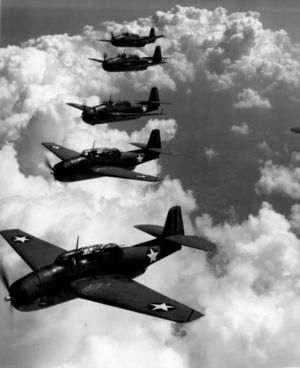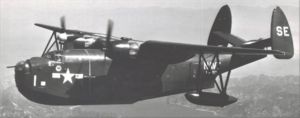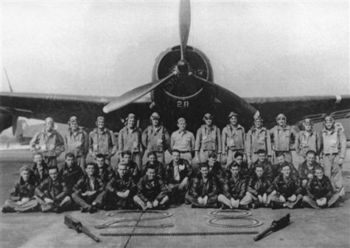Flight 19
 From Conservapedia
From Conservapedia Flight 19 was the designation of a United States Navy training exercise that took place on December 5, 1945 from Fort Lauderdale Naval Air Station, Florida, involving five Grumman TBM Avenger torpedo bombers, which disappeared under still-unknown circumstances and claimed the lives of 27 men: the fourteen men in the flight, as well as an additional 13 men onboard a search and rescue aircraft sent to find them. Although Navy investigators concluded that Flight 19 became disoriented and ditched at sea when the aircraft ran out of fuel, some have questioned the Navy's version in the years since; the resulting speculation helping to develop the Bermuda Triangle legend.
Contents
Mission[edit]
Flight 19 undertook a routine over-water navigation/bombing exercise to give the men advanced combat aircrew training in VTB-type aircraft, of which the Avenger was one. The flight leader, Lieutenant Charles Carroll Taylor, had approximately 2500-flying hours in aircraft of this type, while his trainee students had less than 300; additionally the student officers had 30 flight hours in the Avenger. The aircraft were routinely armed, pre-flighted and filled with enough fuel for a minimum five hours flying before leaving the station at 14:10 local time when the weather was fine, although the sea state was described as moderate to rough. As is customary on many training flights, one of the trainee pilots assumed the role of leader out front, while Taylor flew at the rear. The exercise was called “Navigation Problem 1”, and it involved the flight negotiating a triangular course from Fort Lauderdale due east for 123 miles, then slightly north of north west for 73 miles, crossing Grand Bahama Island, before heading south west for 120 miles back to base. Just 56 miles into the first leg, the aircraft dropped bombs and ran straffing runs as scheduled on a rocky outcropping called Hens and Chickens Shoals, just south of Grand Bahama.
Radio conversations between the pilots were monitored by base and other aircraft in the area, and it is known that the bombing operation was completed successfully. Subsequent conversations indicated that shortly after making their turn on to the second leg of the flight plan a problem began. An unidentified man had asked Powers [one of the students] what his compass read several times, the recorded reply being "I don't know where we are. We must have got lost after that last turn."
One of the flight instructors still at the base awaiting his own take-off was listening in on the transmissions and informed Fort Lauderdale that aircraft were lost. He then called "This is FT-74, plane or boat calling 'Powers' please identify yourself so someone can help you." The response after a few moments was a request from the others in the flight for suggestions. FT-74 tried again and a man identified as FT-28 (Taylor) came on. "FT-28, this is FT-74, what is your trouble?" "Both my compasses are out," Taylor replied, "and I am trying to find Fort Lauderdale, Florida. I am over land but it's broken. I am sure I'm in the Keys but I don't know how far down and I don't know how to get to Fort Lauderdale."
Taylor was advised by the senior instructor to put the sun on his port wing and fly up the coast to Fort Lauderdale, if indeed he was certain he was in the Keys. Operations had also wanted to know if the flight leader had a standard YG (homing transmitter card), which could be used to home in on the tower's radio direction finder. The message was sent but was not acknowledged by FT-28. Instead, at 1645, FT-28 announced: "We are heading 030 degrees for 45 minutes, then we will fly north to make sure we are not over the Gulf of Mexico." During this time no bearings could be made on the flight, and IFF (“Identify-Friend-or-Foe” signal) could not be picked up. Taylor was told to broadcast on 4805 kilocycles; when this order was not replied to, he was asked to switch to 3000 kilocycles, the search and rescue frequency. Taylor's reply: "I cannot switch frequencies. I must keep my planes intact."
At 1656, Taylor did not acknowledge a request to turn on the on-board receiver for the YG; but a few minutes later he was heard calling to his flight "Change course to 090 degrees for 10 minutes." At about the same time, two others in the flight were heard to say "Dammit, if we could just fly west we would get home; head west, dammit!" This was the first indication of panic in the flight.
As the weather worsened, radio contact became more intermittent, and it is believed now that the five aircraft were actually by that time well out to sea east of Florida. Taylor radioed "We'll fly 270 degrees west until landfall or running out of gas".
Lt. Taylor requested a weather check at 17:24, and at 18:04 radioed to his flight "Holding 270, we didn't fly far enough east, we may as well just turn around and fly east again". However in that transmission he was indecisive and obviously not in command, because the transmission indicated more of an opinion than an order. In his last mostly decipherable message, at about 18:20, he was heard saying "All planes close up tight . . .we'll have to ditch unless landfall . . .when the first plane drops below 10 gallons, we all go down together."[1]
At 17:50 several land based stations had triangulated Flight 19's position as being within an electronic 100-mile radius of 29 degrees north, 79 degrees west; Flight 19 was north of the Bahamas and well off the coast of central Florida, but the weak radio reception and interference from radio stations in Cuba meant the pilots could not be reached to give them this information. By that time, bad weather had set in. At 18:20 hours a merchant ship (SS Viscount Empire) had radioed that she was in heavy seas and high winds northeast of the Bahamas, which was approxmately where radio fixes were obtained for the possible location of Flight 19.
At 19:04 a faint message was heard over the airwaves, but the only thing clear about it was the call letters: "FT...FT..." Nothing else was heard again from the flight.
Training 49[edit]
Earlier, as it became obvious the flight was indeed lost, numerous air bases, aircraft and merchant ships were alerted. Several aircraft were dispatched to search for the Avengers and guide them back if they could locate them. Two of them were Training 32 and Training 49, a pair of big PBM-5 Martin Mariner seaplanes which took off at 19:37 from Banana River Naval Air Station at Cocoa Beach, Florida (now Patrick Air Force Base). Training 32 headed due east out toward the Bahamas, while Training 49 followed the Florida coast north before turning northeast out into the Atlantic. Training 49 radioed a routine message to its base a few minutes later, but was never heard from again.[2]
At 19:50 a tanker (S.S. Gaines Mills) reported seeing a mid-air explosion, then flames leaping 120 ft high and burning on the sea for 10 minutes. The captain, Shonna Stanley, reported searching a sea of oil for survivors, but found none. The carrier USS Solomons also reported the explosion, in the exact position which an aircraft they had been observing on radar had vanished from the screen. The unofficial nickname for the Mariner was "the flying gas tank" due to fumes from the aviation fuel constantly leaking into the fuselage, and it had been conjectured that the standard procedure for securing lighters prior to boarding Training 49 may have been overlooked in the face of an emergency, and one of the men might have attempted to light a cigarette. [3]
The Men of Flight 19[edit]
FT. 28 (lead aircraft)
- Charles C. Taylor, Lieutenant, USNR (flight leader)
- George F. Devlin, AOM3c, USNR
- Walter R. Parpart, ARM3c, USNR
FT. 36
- Edward J. Powers, Captain, USMC
- Howell O. Thompson, SSgt., USMCR
- George.R. Paonessa, Sgt., USMC
FT. 3
- Joseph.T. Bossi, Ensign, USNR
- Herman A. Thelander, S1c, USNR
- Burt E. Baluk, JR., S1c, USNR
FT. 117
- George W. Stivers, Captain, USMC
- Robert P. Gruebel, Pvt., USMCR
- Robert F. Gallivan, Sgt., USMC
FT. 81
- Robert J. Gerber, 2nd LT, USMCR
- William E. Lightfoot, Pfc., USMCR
The Men of Training 49[edit]
Aircraft # Buno 59-225
- Walter G. Jeffery, Ltjg, USN (pilot)
- Harrie G. Cone, Ltjg, USN
- Roger M. Allen, Ensign, USN
- Lloyd A. Eliason, Ensign, USN
- Charles D. Arceneaux, Ensign, USN
- Robert C. Cameron, RM3, USN
- Wiley D. Cargill, Sr., Seaman 1st, USN
- James F. Jordan, ARM3, USN
- John T. Menendez, AOM3, USN
- Philip B. Neeman, Seaman 1st, USN
- James F. Osterheld, AOM3, USN
- Donald E. Peterson, AMM1, USN
- Alfred J. Zywicki, Seaman 1st, USN
Inquiry[edit]
The Navy concluded its investigation and published a 500-page report a few months later. The facts of the finding, gathered by then on December 7th, were:
1) Lt. Taylor had mistakenly believed his flight was over the Gulf of Mexico; this was due to his belief that the small islands he had passed over were the Florida Keys and flying to the northeast would lead them to Florida. It was determined that Taylor had passed over the Bahamas as scheduled, and he did in fact lead his flight to the northeast over the Atlantic.
2) Lt. Taylor, although an excellent combat pilot and an officer with no problems with the Navy, had a tendency to "fly by the seat of his pants" and getting lost several times in the process. It was twice during such times that he had to ditch his planes in the Pacific and be rescued.
3) Blame for the loss of Flight 19 was placed upon Lt. Taylor.
4) The loss of Training 49 was attributed to a mid-air explosion.[4]
The following year, this report was amended by the Navy in response to the demands of Lt. Taylor's mother, who contended that the Navy was unfairly blaming her son for the loss of five aircraft and 14 men, when the Navy had neither the bodies or the airplanes as evidence. The findings of the report were subsequently changed to "cause unknown".
Had Flight 19 actually been where Taylor believed it to be, landfall with the Florida coastline would have been reached in a matter of 10 to 20 minutes or less, depending on how far down they were. However, a later reconstruction of the incident showed that the islands visible to Taylor (Hens and Chickens Shoals) were probably the bombing target, well east of the Keys, and that Flight 19 was exactly where it should have been. The Board of Enquiry found that because of his belief that he was on a base course toward Florida, Lt. Taylor actually did guide the flight further northeast and out to sea. Further, it was a general order at NAS Ft Lauderdale for any flyer reporting himself lost to turn his plane around to 270 degrees and fly west, leading him straight to Florida; this order was drummed into every student pilot for safety reasons. It is still unknown why this order had failed with regard to Flight 19.
The fact that very few searches have concentrated on the vast open ocean areas could explain why the planes have never been found. By the time the pilots turned west, they were likely so far out to sea that there was little hope of rescue, even if they had managed to stay afloat. [5] [6]
Bermuda Triangle connection[edit]
In the April 1962 issue of American Legion Magazine, author Allen W. Eckert was the first to write of the "popular" reasons for the disappearance of Flight 19. Among them, it was claimed Taylor had been heard saying "We are entering white water, nothing seems right. We don't know where we are, the water is green, no white". It was claimed that officials at the Navy board of inquiry stated that the planes "flew off to Mars". Eckert's story, "The Lost Patrol", was the first to connect the supernatural to Flight 19, but it would take another author, Vincent Gaddis, writing for Argosy Magazine (February 1964)[7] to put Flight 19 together with other mysterious disappearances, coin a new catchy name, and call the whole "The Deadly Bermuda Triangle"; he would build on that article with a more detailed book (Invisible Horizons) the next year. Other's would follow with their own works: John Wallace Spencer (Limbo of the Lost, 1969); Charles Berlitz (The Bermuda Triangle, 1974); Richard Winer (The Devil's Triangle, 1974), and many others, all keeping to some of the same supernatural elements outlined by Eckert. Berlitz, grandson of a distinguished linguist and author of various additional books on anomalous phenomena, attributed the loss of Flight 19 to anomalous or unexplained forces, despite lack of evidence supporting his claim.
Cpl Allan Kosnar[edit]
Corporal Allan Kosnar, USMC, would have been the third man onboard FT-81, but he had requested to get out of the flight due to sickness. Various authors on the Bermuda Triangle have speculated that Kosnar had "premonitions" not to go on the flight. In one Triangle book (by Adi-Kent Thomas Jeffrey), it was Corporal Eagle Boloton who was to have taken the flight (Kosnar was not mentioned in her book). Another mentioned in the Triangle books as having had premonitions not to go on the flight, but his request to get off was refused, was Lt. Taylor himself.
References[edit]
- "Lost Patrol", Naval Aviation News. June 1973, pp. 8-16; reported at U.S. Navy Historical Center FAQ
- "Great Hunt On For 27 Navy Fliers Missing In Six Planes Off Florida," New York Times, December 7, 1945.
- "Wide Hunt For 27 Men In Six Navy Planes," Washington Post, December 7, 1945.
- "Fire Signals Seen In Area Of Lost Men," Washington Post, December 9, 1945.
External links[edit]
- Partial transcript of the official Navy investigation, dated 7 DEC 1945: [8]
- Text of Feb. 1964 Argosy Magazine article by Vincent Gaddis
- Navy Report on Flight 19 Disappearance
- Flight 19 and Bermuda Triangle
- Disappearences in the Bermuda Triangle and Flight 19
- BBC Documentary on Flight 19
Categories: [Theories]
↧ Download as ZWI file | Last modified: 03/03/2023 09:20:01 | 3 views
☰ Source: https://www.conservapedia.com/Flight_19 | License: CC BY-SA 3.0
 ZWI signed:
ZWI signed:



 KSF
KSF